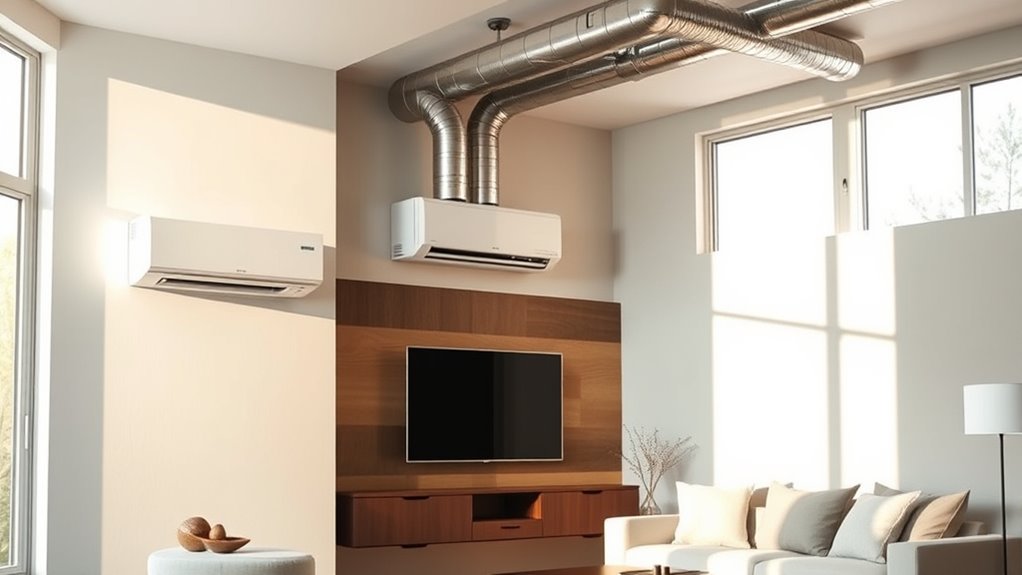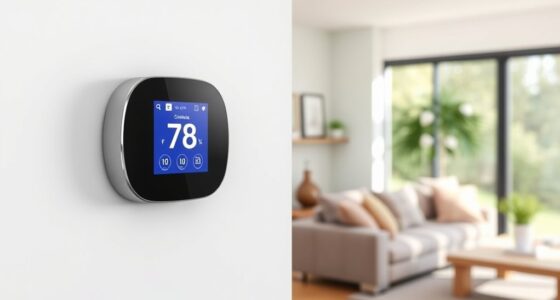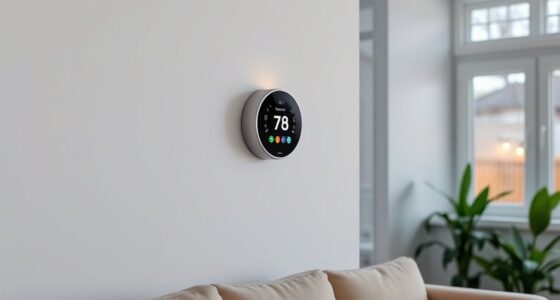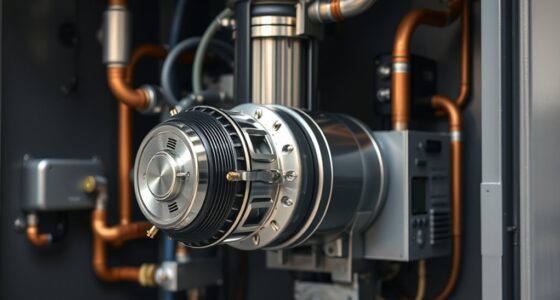Choosing between ductless mini-splits and central HVAC depends on your home’s layout, energy goals, and budget. Mini-splits are more energy-efficient and easier to install, making them ideal for retrofits or zoning specific rooms. Central systems provide whole-house comfort but require extensive ductwork and higher initial costs. Consider your needs and priorities, and explore further, to find the best option that fits your home and lifestyle.
Key Takeaways
- Ductless mini-splits offer targeted, energy-efficient climate control and lower installation costs, ideal for retrofits and specific rooms.
- Central HVAC systems provide whole-house comfort with centralized control but involve higher installation costs and ductwork.
- Mini-splits are flexible and easily adaptable to various home layouts, whereas central systems require comprehensive duct infrastructure.
- Consider your budget, home size, and whether you need zone-specific or whole-house heating and cooling.
- Long-term energy savings and installation complexity are key factors in choosing the most suitable system.

Are you unsure whether to choose ductless mini-splits or a central HVAC system for your home? Making this decision depends on several factors, but two key considerations are energy efficiency and installation costs. Ductless mini-splits are known for their high energy efficiency because they allow you to target specific rooms or zones, reducing wasted energy. Unlike central systems, which distribute conditioned air throughout an entire house via a network of ducts, mini-splits let you control the temperature room by room. This zoning capability means you’re not heating or cooling spaces you don’t use, saving you money on energy bills over time. If energy efficiency is your top priority, mini-splits often come out ahead, especially in homes where only certain areas need climate control or where existing ductwork is inefficient or nonexistent.
When it comes to installation costs, the difference is significant. Installing a central HVAC system typically involves running ductwork through your entire house, which can be labor-intensive and expensive. The cost of materials, labor, and potential modifications to your home’s structure can add up quickly. In contrast, ductless mini-splits usually require a much simpler installation process. They involve mounting an outdoor compressor and indoor air handlers, with minimal disruption to your walls or ceilings. Because of this, installation costs for mini-splits are generally lower, making them an attractive option if you’re looking to save upfront. However, keep in mind that if you need to cool or heat multiple rooms, you’ll need multiple indoor units, which could increase the overall cost. Still, even then, the total expense often remains less than retrofitting a central system, especially in older homes with limited ductwork.
Additionally, the flexibility of installation makes mini-splits a versatile choice for various home layouts and renovations. Ultimately, choosing between ductless mini-splits and a central HVAC system comes down to your specific needs and budget. If you want maximum energy efficiency and minimal installation costs, mini-splits provide a flexible and cost-effective solution. They’re especially ideal for retrofit projects, room additions, or homes without existing ductwork. On the other hand, if you’re seeking a whole-house solution with centralized control and have the budget for a more extensive installation, a central HVAC system might suit you better. Both options have their advantages, so weigh your priorities carefully. Consider your long-term energy savings, upfront costs, and how you prefer to control your home’s climate. This way, you can make an informed decision that aligns with your comfort and financial goals.
Frequently Asked Questions
How Long Do Ductless Mini-Splits Typically Last?
Ductless mini-splits typically last around 12 to 15 years with proper maintenance. To maximize their lifespan, you should perform regular filter cleanings and keep the outdoor unit clear of debris. Maintenance requirements are generally minimal but essential, like checking refrigerant levels and inspecting for leaks. By staying on top of these tasks, you can guarantee your ductless system operates efficiently and lasts as long as possible.
Are Ductless Systems More Energy-Efficient Than Central HVAC?
Yes, ductless systems are generally more energy-efficient than central HVAC units. They offer significant energy savings because you can cool or heat specific rooms without wasting energy on unused spaces. This targeted approach reduces your environmental impact by lowering overall energy consumption. Plus, their modern technology guarantees ideal performance, helping you save money on utility bills while being more eco-friendly.
Can Ductless Systems Be Used for Heating and Cooling Simultaneously?
Yes, ductless systems can heat and cool simultaneously, giving you unmatched zoning flexibility. Imagine controlling different rooms at once, each with tailored comfort. This dual functionality minimizes aesthetic impact since no ductwork is needed, preserving your home’s look. It’s perfect if you want customized temperatures without sacrificing style. With ductless units, you enjoy seamless comfort, energy efficiency, and a sleek appearance—making your space more comfortable and visually appealing.
What Is the Initial Installation Cost Difference?
The cost comparison shows ductless mini-splits usually have lower installation expenses than central HVAC systems. You’ll spend less upfront because mini-splits don’t require ductwork, which can be costly and time-consuming to install. Central systems often need extensive ductwork and higher labor costs, making their initial installation more expensive. If you want to save on installation costs, ductless mini-splits are a more affordable option upfront.
Do Ductless Systems Require Regular Maintenance?
Ductless systems do require regular maintenance to keep them running efficiently. You should check and replace filters regularly to guarantee good airflow and air quality. Additionally, refrigerant levels need to be monitored and topped up if necessary, as low levels can reduce performance. Routine maintenance also includes cleaning the indoor and outdoor units and inspecting for any issues, helping you avoid costly repairs and extend the system’s lifespan.
Conclusion
Ultimately, choosing between ductless mini-splits and central HVAC depends on your home’s needs and your budget. Did you know that ductless systems can save up to 30% on energy costs? This means you’ll not only enjoy better temperature control but also lower utility bills. Consider your space, preferences, and long-term savings to make the best choice. Whichever option you pick, investing in quality HVAC can boost your comfort and reduce energy waste.









